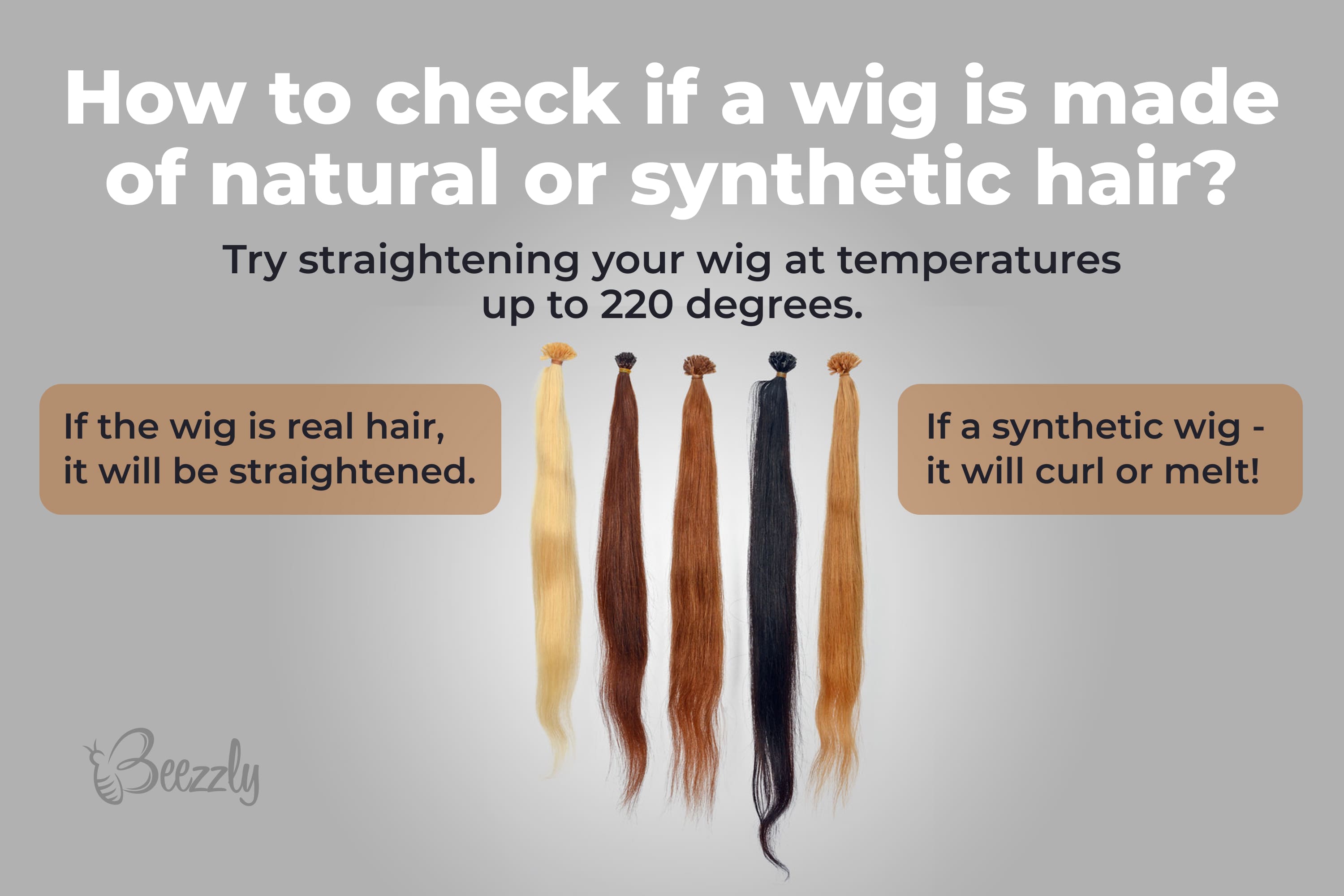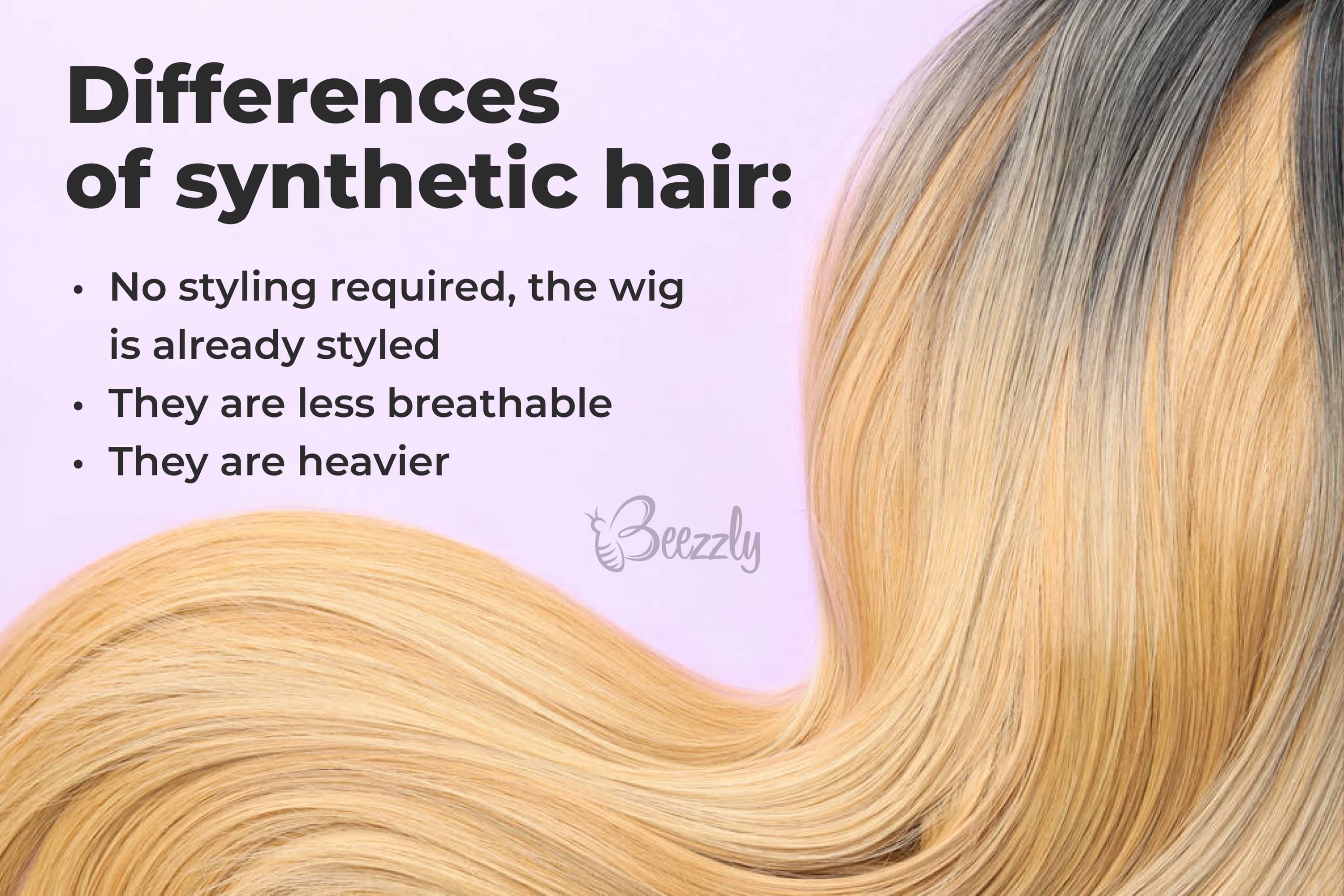A wig can be an easy way to adjust and change your appearance for many reasons. Those who perform on stage, as well as those who just like changing their look often enough frequently opt for wigs.
This is the best and the quickest way to change your hair color, length, and style without dyeing or styling each time. As a result, you get your new fabulous look and your mane remains healthy.
However, if you want your new appearance to look natural and real, you might want to consider buying a human hair wig. Unlike synthetic wigs, those that are made of human hair look and feel real.
But here is the question: how to tell a human hair wig from a synthetic wig?
To quite many people this synthetic vs real hair wigs issue really becomes a challenge!
In this article, we will explain how you can tell the difference between a human hair wig and its synthetic alternative. Also, we will share a simple test with you.
With its help, you will be able to check which kind of wig is in front of you. Finally, we will explain what else makes these two categories of wigs distinct.
Human vs Synthetic Hair Wigs. How to Distinguish Them?
The industry of wig making has developed and improved so much that nowadays it is very hard to figure out which wig is synthetic and which wig is not. So apparently, if you come to a wig shop to buy an item, you might need to know how to figure it out. There is one simple test you can make use of.
By the way, this test can be very helpful for those who order wigs on the internet! When you buy online, you don’t have an opportunity to check the item before it is delivered.
As a result, you have to wait until the package arrives so that you can see what you have ordered. And quite often, people don’t get exactly what they ordered…

This is why, in order to avoid such a sad scenario, you can always use a simple test. You just need to slightly burn your wig! Yes, it sounds strange and crazy, but this is the quickest and the most effective way to tell what you are dealing with – a human hair wig or a synthetic replica.
Why would you set your new wig on fire?!
See, the simplest way to conduct a test is to do a “fiber burn”. A “fiber burn” will identify the chemical composition of your hair extensions or a wig.
By the way, it is a standard test conducted in the textile industry to determine the fiber contents of fabric! In addition, the same kind of test can be done on hair to determine its fiber contents.
Here is how this test should be done correctly.
- Establish an area to test the wig. There should be no flammable materials such as curtains, papers, cardboards, oils, grease, or wrappers around the area!
- Secure your own hair by pulling it back. You can tie up a bun since it is the safest option. If you wear a ponytail or a braid, chances are that they catch the fire!
- Light a candle (an interior candle would be an ideal option since it is stable and will hardly fall)
- Make sure your candle is resting in a candle holder or standing on the surface properly
- Using a pair of tweezers, bring a small section of your wig fiber to the candle flame and observe
It is very important that during the burning process, you watch closely how your wig fibers burn! You need to pay attention to how it burns, what smell it emits while burning, how easily it can be extinguished, and even what kind of ash it leaves behind!
If you do everything right, you will be able to notice significant distinctions. Below you can see which ones exactly.

How Human Hair Wig Would Burn?
First of all, you should know that Human hair is not that easy to burn! If you light up a few fibers from a wig made of real human hair, the hair will start rolling when the fire is close.
Also, you will see that it is difficult to burn up. If you are dealing with human hair, which is a protein fiber, you will also see that it burns briefly and will not continue to burn unless you keep holding it to the fire.
When you are burning real human hair, the flame will be orange, and the hair will char, leaving dark ash that turns to powder if you crush it. The odor is also hard to mistake for something else: human hair wigs smell of burning flesh or burning feathers.

How Would a Synthetic Wig Burn?
Synthetic hair is either made of nylon fibers or polyester fibers, which burn pretty much the same. Nylon fibers burn rapidly and then they simply melt.
The flame you see will be sparkling, having a blue base and orange tip. And if you take a look at the ash, you will notice that it is similar to hard amber beads and smells of boiling green vegetables. When you burn synthetic hair, it may also have the smell of plastic.
Polyester fibers will also burn and melt quite rapidly. The sputtery flame will be orange, producing black smoke. During the process of burning, you will see that the fiber melts, drips then become sticky to the touch, and finally forms ash of hard black beads.
By the way, if you are afraid of testing your wig but you can only do it at home, the kitchen or bathroom sink will be an ideal place for it! See, the sink itself is not easily damaged by fire and besides, during the process of fire testing, you will always have an easy access to water.

Test Your Wig With a Hair Straightener
This is another way to test your new wig to see whether it is of real hair or synthetic. To perform this one, you will only need your hair straightener and a wig. Yes, this option is way less extreme!

- Plug your straightener in
- Adjust the temperature of the hair straightener up to 220 degrees
- Wait for the high temperature
- Gently straighten your wig. You need to pull 4-5 times
- If the wig is of real human hair, it will be straightened. But if you have a synthetic wig, it will be curled or melted!
Like this, now you have a complete understanding of how to tell the difference between synthetic wigs and human hair wigs. With the help of the tests we shared with you, you will easily manage to figure out what sort of item you have.

Human Hair vs Synthetic Hair. Major Distinctions
Except for being able to check what type of fiber your wig is made of, it is also useful to know what other factors make the two types of wigs different. Below, you can read about the most common nuances and features that synthetic wigs and human hair wigs have. Like this, you might not even have to perform the fire test!
Human Hair Wigs
If you take a closer look at the wigs made of human hair, you will see that they have certain features that make them stand out.

- They are typically much more expensive than synthetic wigs
- They are much more versatile in terms of styling with heat
- They can be colored and dyed
- Human wigs have more longevity than synthetic wigs
- They come with more types of cap constructions to select from ranging from full lace, glueless full lace, front lace, etc.
- Human hair wigs are also generally much lighter and consequently, more comfortable to wear
- They are usually more breathable as well
These wigs also have different types and grades. For example, Remy human hair is highly desired because all the follicles align from root to tip, which makes the wig less likely to tangle. Wigs made of virgin hair are also in demand since there is no processing involved, which makes the hair last longer.

Synthetic Hair Wigs
Wigs that are made of synthetic fibers also have certainly noticeable distinctions that can easily let you know what material they are made of.
- These wigs come pre-styled so there is no need for you to waste time on styling
- Synthetic wigs are extremely efficient in terms of use. You just need to put it on!
- If you take a synthetic wig in one hand and a human hair wig in another hand, you will see that the synthetic one feels a bit heavier
- They are often less breathable than human hair wigs
Now that you know what else makes synthetic and human hair wigs distinct, let’s find out how to wear it correctly so that you avoid causing damage to the item and to your scalp and hair.

Things You Don’t Do When Wearing a Wig
Since wearing a wig means that your natural hair is hidden under the wig cap for quite a lot of time, it is essential to realize how you should wear the item correctly. Otherwise, if you do it wrong, you may end up with scalp irritation or other unpleasant issues.

Don’t Sleep With Your Wig On!
If you sleep with the wig put on regularly, your scalp will not thank you.

With the wig on, the skin on your head will be suffocating during the night without proper ventilation, unable to breathe! As a result, it will soon develop irritation and probably also itching.

Make Sure Your Wig Is the Right Size
Double-check your head measurements before you buy a wig! It should fit you as comfortably as possible. Wearing the right-sized wig will not only help prevent it from sliding on your head. It will also help you avoid itchiness on your scalp.

Switch Up Your Wigs
If you are going to wear a wig every day, consider investing in extra wigs as well to shift them between washings. Since each wig will be used less often, they will have less wear and tear damage over time.

Wear a Wig Cap Liner
Wearing nylon, mesh, or bamboo wig cap liner can help keep your wig clean. This cap will create a barrier between the wig and the oils on your scalp. In addition, wig cap liners will also help keep your real hair properly protected under the wig and ensure a comfortable fit.
Now you know a lot more about wigs than you did before! You found out whether synthetic hair burns and how you can test your wig for being natural or artificial. Also, you learned what else makes human hair wigs and synthetic wigs different.
Finally, you are now aware of a few tips that will help you keep your wig in a decent state and also protect your hair and scalp from irritation, itching, and other similar conditions caused by the wrong method of wearing wigs.

[wp-faq-schema title=”Frequently Asked Questions”]

Hello everyone! If there are people who are knowledgeable in wigs, I need your help! Can you straighten synthetic wigs? And if you can, then what tools are best to be used for that? Thank you!
Hello! Well, unlike human hair wigs, synthetic wig fibres won’t be able to tolerate the high heat produced by hair straighteners! So unless you have a heat resistant wig, straightening it with a hair straightener will cause irreversible damage to the hair fibres.
What to do if my synthetic wig has frizzy ends? The wig is about three years old and I used to wear it often at first. However, the overall condition is still fine except for the tips. Is it possible to fix them somehow?
Well, I can only recommend you wash your wig and then apply a conditioning spray to it. Or maybe some dry shampoo could also help! At least this is what I do to my wig when I notice frizz, and it usually helps.